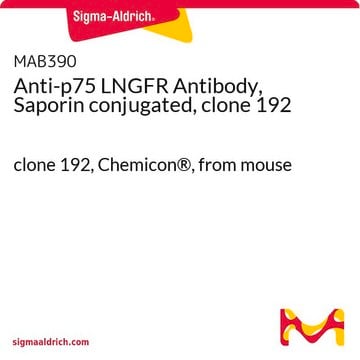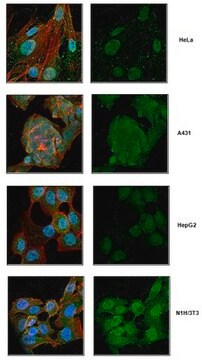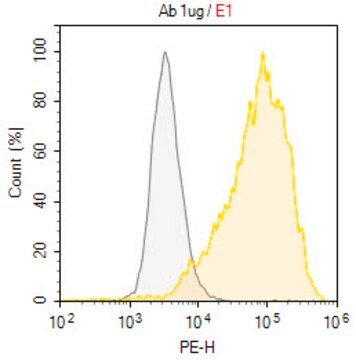MAB365
Anti-Nerve Growth Factor Receptor Antibody, extracellular, clone 192-IgG
clone 192-IgG, Chemicon®, from mouse
Sinónimos:
CD271 antigen, Low affinity neurotrophin receptor p75NTR, Low-affinity nerve growth factor receptor, NGF receptor, low affinity nerve growth factor receptor, nerve growth factor receptor, nerve growth factor receptor (TNFR superfamily, member 16), p75 IC
About This Item
Productos recomendados
origen biológico
mouse
Nivel de calidad
forma del anticuerpo
purified antibody
tipo de anticuerpo
primary antibodies
clon
192-IgG, monoclonal
reactividad de especies
rat
fabricante / nombre comercial
Chemicon®
técnicas
immunocytochemistry: suitable
immunohistochemistry: suitable
immunoprecipitation (IP): suitable
western blot: suitable
isotipo
IgG1
Nº de acceso NCBI
Nº de acceso UniProt
Condiciones de envío
wet ice
modificación del objetivo postraduccional
unmodified
Información sobre el gen
human ... NGFR(4804)
Descripción general
Especificidad
Inmunógeno
Aplicación
Neuroscience
Neurochemistry & Neurotrophins
1-5 µg/mL (Non-reducing conditions only) was used on a previous lot.
Inhitibition Assay:
Inhibition on NGF binding {Chandler, 1984}.
Immunoprecipitation:
5 µg/mL, 0.5% triton X-100 buffer; PC12 positive control was used on a previous lot.
Immunohistochemistry:
1-5 µg/mL on rat spinal chord, of a previous lot was used. Other fixatives and methods can also be used.
Calidad
1-5 µg/mL on rat , of a previous lot, (spinal chord, see protocol below); other fixatives and methods can also be used.
Descripción de destino
Ligadura / enlace
Forma física
Almacenamiento y estabilidad
Nota de análisis
Western Blot: NGF-differentiated PC12 cell lysate.
Immunohistochemistry: Rat brain tissue.
Otras notas
Información legal
Cláusula de descargo de responsabilidad
¿No encuentra el producto adecuado?
Pruebe nuestro Herramienta de selección de productos.
Código de clase de almacenamiento
10 - Combustible liquids
Clase de riesgo para el agua (WGK)
WGK 2
Certificados de análisis (COA)
Busque Certificados de análisis (COA) introduciendo el número de lote del producto. Los números de lote se encuentran en la etiqueta del producto después de las palabras «Lot» o «Batch»
¿Ya tiene este producto?
Encuentre la documentación para los productos que ha comprado recientemente en la Biblioteca de documentos.
Nuestro equipo de científicos tiene experiencia en todas las áreas de investigación: Ciencias de la vida, Ciencia de los materiales, Síntesis química, Cromatografía, Analítica y muchas otras.
Póngase en contacto con el Servicio técnico








